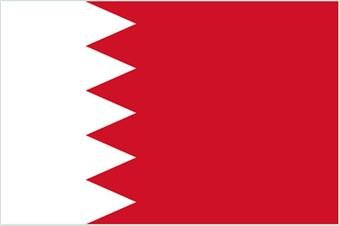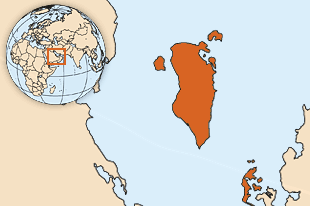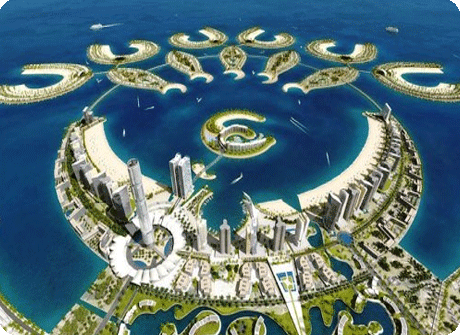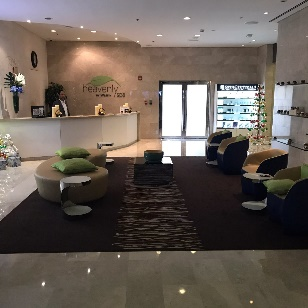

The Kingdom of Bahrain
1. Statistics
Total population (2016) 1,425,000
Gross national product per capita (international PPP dollars, 2012) 36,140
Estimated life expectancy at birth m/w (years, 2016) 79/80
Probability of dying (per 1,000 live births, 2018) under age five 7
Probability of death aged 15-60 years m/w (per 1,000 live births, 2016) 61/50
Total health care expenditures per capita (in international dollars, 2014) 2.273
Total health care expenditures as a % of GNP (2014)
2. General information about the country

The main advantage of Bahrain is the bright sun 360 days a year and the warm, clear sea. Almost the entire coast is one giant beach, intensively built up with resort complexes.
In 2007, the country's population was 708,573, about half of whom were immigrant workers and their families, mostly from Iran; there are many natives of Europe and South Asia.
The capital, the port city of Manama (137,000 residents), is located in the northeast. Bahrain is a major trade center (one of three free trade zones in the Persian Gulf).
Bahrain is a constitutional monarchy. The head of state is the king (until 2002 - emir). The government is headed by the prime minister. The cabinet consists of 23 ministers.
There is a bicameral parliament. The lower chamber - the Chamber of Deputies is elected by popular vote, the upper chamber - the Consultative Council (Majlis al-Shura) is appointed by the king. Both chambers have 40 members each.
There is a bicameral parliament. The lower chamber, the Chamber of Deputies, is elected by popular vote; the upper chamber, the Consultative Council (Majlis al-Shura), is appointed by the king. In both chambers sit 40 people each.
The country's advantages: oil and gas deposits, a developed offshore banking sector, domestic investment, tourism, aluminum production, and almost complete self-sufficiency in food.
Weaknesses: exhausted oil reserves, insufficient reorientation to other industries. High unemployment (15%) and government loans.
Development of tourism in the country is currently a government program.
The Kingdom of Bahrain is small in size, but it is one of the states with a steadily growing economy and is also gaining status in the field of tourism. Consequently, health care here is at a decent level for both locals and tourists. The level of medical care has improved dramatically since Bahrain's independence.
Bahrain has enjoyed a system of universal healthcare since the 1960s. Citizens of Bahrain and subsidized non-Bahrainis. According to the World Health Organization, the cost of health care amounted to 4.5% of Bahrain's GDP. Bahrain's doctors and nurses make up the majority of the country's workforce in the health sector, unlike in the neighboring Gulf states.
3. Bahrain's Health (Prevention) System

On December 1, 2018, Bahrain's Health Insurance Law No. 23 of 2018 came into force. It establishes the National Health Regulatory Authority, which will create a special health insurance fund agreed to by the Supreme Council of Health. The fund will be invested and managed by an elected Board of Directors. Insurance premiums would be collected by health care providers. There are also plans to create a Health Information and Knowledge Management Center that will collect, analyze and process health-related data using electronic health records for all beneficiaries. All citizens, residents and visitors will have to pay for mandatory health insurance. Benefits are provided by law. Employers must pay premiums for the insurance of their foreign employees and in some cases their family members as well. Bahraini citizens can access voluntary health insurance packages through the Fund, which will cover 60% of the costs of hospitals or private sector facilities. Foreign visitors are covered for emergency medical care, although the cost of visas will rise.
Health care pricing is based primarily on the division of medical facilities into public and private. Traditional medicine in Bahrain was almost on a par with official medicine. It still exists, but today in Manama (the capital) there are large medical facilities with modern equipment and narrow specialists (local and foreign). For example, the Salmaniya Medical Complex. Evaluate the level of health care statistics, according to which the life expectancy of the local population has increased to about 70 years threshold.
In general, public and private hospitals throughout the kingdom has at least fifty. There is no shortage of medicines in pharmacies. Ambulance services and public facilities are free for local residents, although private practitioners can also conduct appointments and treatment on the basis of public facilities.
4. Health characteristics of the Bahrain population and health programs.
The incidence of malaria and tuberculosis in Bahrain has declined in recent decades and cases are becoming rare among Bahraini citizens. The Ministry of Health sponsors regular vaccination campaigns against TB and other diseases (Hepatitis B).
Bahrain's population is currently obese (28.9% of all men and 38.2% of all women). Researchers involved in the WHO-sponsored MONICA Project found that 15.6% of boys and 17.4% of girls in high school were obese. Bahrain also has one of the highest prevalence rates of diabetes in the world (5th), with more than 15% of the Bahraini population suffering from the disease and accounting for 5% of deaths in the country.
Cardiovascular disease accounts for 32% of all deaths in Bahrain, the number one cause of death (cancer is second). Sickle cell anemia and thalassemia are common in the country (18% of Bahrainis are carriers of sickle cell anemia and 24% are carriers of thalassemia).
Bahrain has also introduced stricter smoking laws in the last 10 years. Studies have shown that the main health problem among the population is coronary heart disease, so laws have been issued to help the health of the country's population. The largest ban passed by Bahraini leaders is a ban on smoking or using tobacco products in public places.
5. The best clinics in Bahrain
The best clinics in Bahrain are:
Al Amala Hospital (Hamad City), Al Hilala Hospital (Muharraq), Al Qindi Specialty Hospital (Manama), American Mission Hospital (Manama), Awali Hospital, Bahrain Juffair Hospital, Bahrain Defense Force Hospital, which is also known as "Bahrain Royal Medical Services or Military Hospital" (Riffa), Darkulaib Hospital, Dr. Tariq Said Hospital, Dr. Sulaiman Medical Center (Al-Habib), Bay German Orthopedic Hospital, Dental Specialty Hospital, *Dr. Wiem Clinic for Endocrine patients, Bay Diabetes Center, Ibn Al-Nafez Hospital, Bahrain International Hospital, International Medical City Hospital (East Riffa), Iran Specialist Hospital, KIMS Bahrain Medical Center, King Hamad Busaiteen University Hospital, Noor Specialist Hospital (Manama), Royal Bahrain Hospital, Salmaniya Medical Complex (SMC) Hospital, Sitra Polyclinic, Shifa Al Jazeera (Ras Rumen Manama), Urology & Plastic Surgery Hospital (UPS), Dr. Abir Kosmplasty Clinic - Zinj
Text translated by a representative of «Russian Medical Women’s Association» Bondarenko Anastasia




